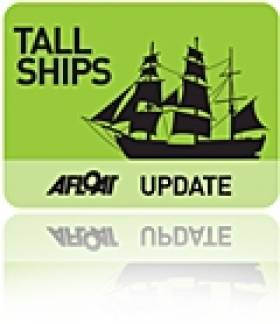Displaying items by tag: Maintenance Dry Docking
#JeanieJohnston - The replica 19th barque Jeanie Johnston departed her role as a static famine emigrant museum ship along Dublin's Custom House Quay, as she is to undergo 'essential maintenance', writes Jehan Ashmore.
Jeanie Johnston's short tow downriver was carried out by Dublin Port Company tug sisters, Beaufort and Shackleton, which involved transiting through two bridges, firstly the Samuel Beckett swing-bridge and then the East-Link toll-lift bridge.
The three masted vessel temporally moored alongside the North Quay Wall Extension next to the East-Link where the tugs are stationed. As of this morning she berthed alongside the lead-in jetty of Dublin Graving Docks Ltd's facility within Alexandra Basin. Again this operation involved the pair of tugs in which the Shackleton had only recently vacated the same graving dock.
Due to the dry-docking, tours of the replica tallship will not be available from today, however they are due to resume on 22 October. The 50 minute tours tell the story of how Irish emigrants during the famine departed these shores in the hope of survival and seeking a future in the 'New World'.
The original Jeanie Johnston was built in Quebec, Canada in 1847. She carried more than 2,500 people from Ireland on 16 crossings to North America between 1848 to 1855.
As for the replica, she became the floating museum following a short-lived career 'sailing' around Irish ports and several trips to Spain. Her high-point was the 'reinactment' voyage from Tralee to North America in 2003 with calls to U.S. and Canada.
In 2005, she took part in the Tall Ships Races from Waterford and in that same year she was brought by the Dublin Docklands Development Authority to become her present role as a city-centre tourist attraction.
At the time of her sale by Tralee Town Council and Kerry County Council, there were fears that the barque built in Tralee, Co. Kerry, amid controversial circumstances and cost overruns would be sold abroad and never to return.
Following the sinking of the state owned STV Asgard II in 2008, there were calls for Jeanie Johnston to be reactivated as a sail training vessel to replace the brigantine lost off Brittany.
























































